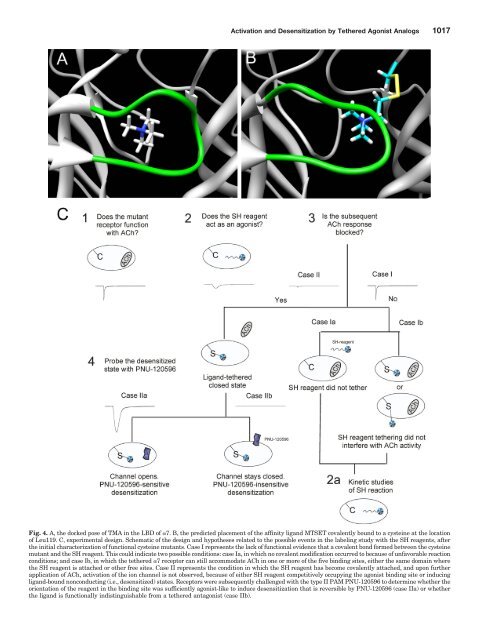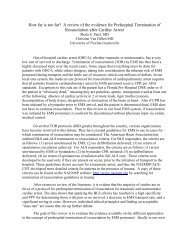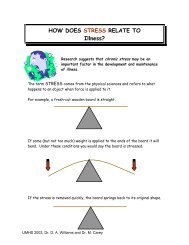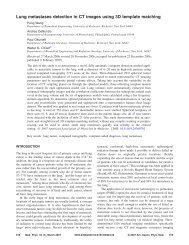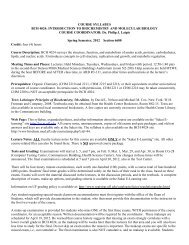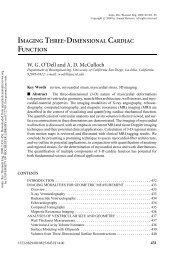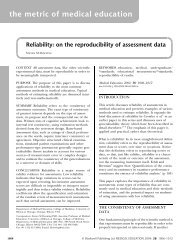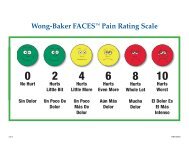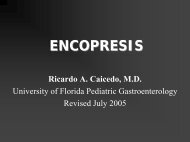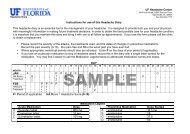1016 Wang et al.represents two possibilities: failure <strong>of</strong> the SH reagent to reactwith the receptor (case Ia), or failure <strong>of</strong> the modification toresult in a detectable change in function (case Ib). A thirdoutcome that might also have been anticipated is that receptorswould be modified in such a way as to have increasedsensitivity to ACh (case III), which is not illustrated in thefigure.An important caveat to results that appeared intermediatebetween those anticipated for cases I and II is that theremight be significant difference in the reaction rates for thevarious covalent modifications; therefore, in such cases, kineticstudies were also conducted (experiment 2A). Oncereceptors were determined to be conditionally induced into acovalently modified state that was unresponsive to furtheractivation by ACh, we hypothesized that (case IIb) the tetheredligand might be situated as a simple antagonist, eitheroccluding the access <strong>of</strong> the LBD to agonist or holding thereceptors in a nonactivatible state or (case IIa) that thetethered agonist might function like an agonist that, after atransient phase <strong>of</strong> activation, stabilizes the receptor in adesensitized conformation that might be reactivated by thetype II PAM PNU-120596. Experiment 4, the application <strong>of</strong>PNU-120596 was conducted to make this determination. Finally,experiment 5, a follow-up application <strong>of</strong> ACh, probesthe PNU-120596 potentiation <strong>of</strong> this ACh response as affectedby the sulfhydryl-reacted receptors.The Basic Effects <strong>of</strong> Cysteine Mutagenesis. In thehuman 7 nAChR, a single, nondisulfide bonded free cysteineis found at position 116, which, if left intact, couldcomplicate the interpretation <strong>of</strong> thiol-specific labeling studieswhen cysteine is introduced elsewhere in the receptor. Thereforethe 7 C116S mutant (<strong>Papke</strong> et al., 2010) was preparedand used as the background for all additional cysteine mutants.The mutants used for these studies were selected froma total <strong>of</strong> 44 7 LBD cysteine mutants reported elsewhere(<strong>Papke</strong> et al., 2010). The cysteine mutations at Ser36, Leu38,Trp55, Leu119, and Ile165 (Fig. 1B) were selected for furtherstudy in these experiments based on their strategic placementwithin the LBD and also because these cysteine mutationshad relatively little impact on receptor function beforeSH modifications. When control applications <strong>of</strong> AChwere made to oocytes expressing these mutants (experi-Fig. 3. Intrinsic agonist activity <strong>of</strong> SH reagentagonist analogs for wild-type 7 and7 C116S. Top, representative traces <strong>of</strong>wild-type 7 and 7 C116S to Br-ACh andMTSET displayed with ACh control responsesobtained from the same oocytes.Bottom, concentration-response curves forBr-ACh and MTSET, normalized to themaximal ACh-evoked responses. Each pointrepresents the average response <strong>of</strong> at leastfour oocytes ( S.E.M.).
Activation and Desensitization by Tethered Agonist Analogs 1017Fig. 4. A, the docked pose <strong>of</strong> TMA in the LBD <strong>of</strong> 7. B, the predicted placement <strong>of</strong> the affinity ligand MTSET covalently bound to a cysteine at the location<strong>of</strong> Leu119. C, experimental design. Schematic <strong>of</strong> the design and hypotheses related to the possible events in the labeling study with the SH reagents, afterthe initial characterization <strong>of</strong> functional cysteine mutants. Case I represents the lack <strong>of</strong> functional evidence that a covalent bond formed between the cysteinemutant and the SH reagent. This could indicate two possible conditions: case Ia, in which no covalent modification occurred to because <strong>of</strong> unfavorable reactionconditions; and case Ib, in which the tethered 7 receptor can still accommodate ACh in one or more <strong>of</strong> the five binding sites, either the same domain wherethe SH reagent is attached or other free sites. Case II represents the condition in which the SH reagent has become covalently attached, and upon furtherapplication <strong>of</strong> ACh, activation <strong>of</strong> the ion channel is not observed, because <strong>of</strong> either SH reagent competitively occupying the agonist binding site or inducingligand-bound nonconducting (i.e., desensitized) states. Receptors were subsequently challenged with the type II PAM PNU-120596 to determine whether theorientation <strong>of</strong> the reagent in the binding site was sufficiently agonist-like to induce desensitization that is reversible by PNU-120596 (case IIa) or whetherthe ligand is functionally indistinguishable from a tethered antagonist (case IIb).


